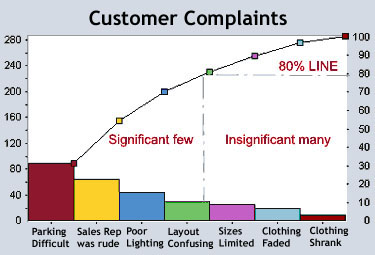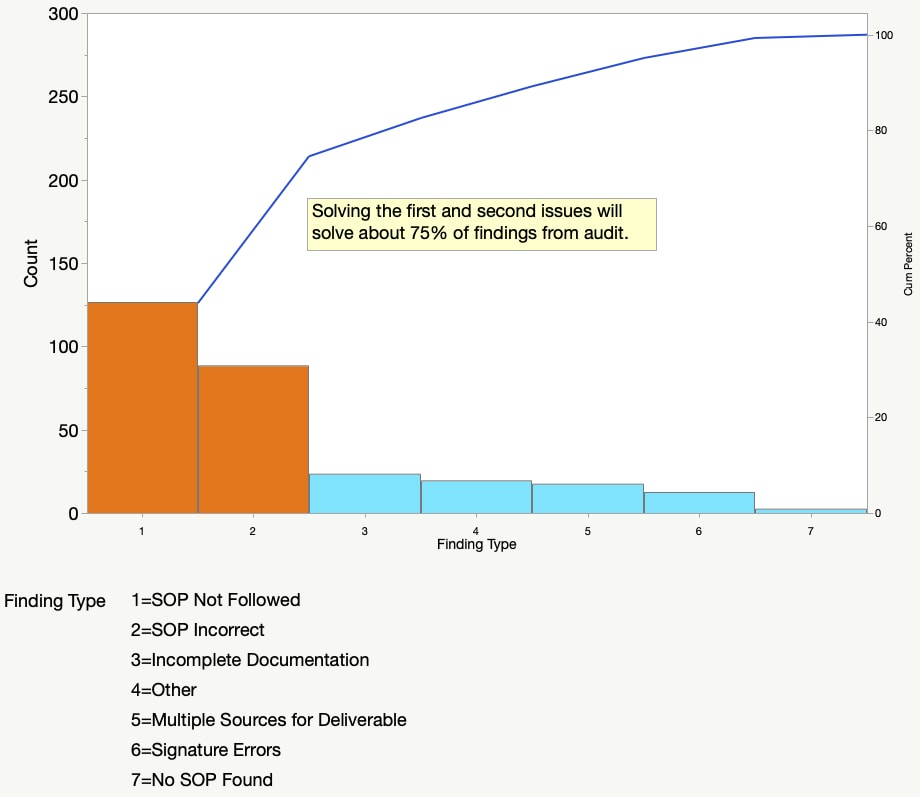The bars are placed on the graph in rank order that is the bar at the left has the highest contribution to counts or cost. Flow and process charts are used to describe the system and processes of the hospital.

Pareto Chart Template Flow Chart Template Templates Printable Free Flow Chart
Pareto charts are used to.

. Each vertical bar represents the contribution to the total from a given problem area. A Pareto chart is a bar chart named after Italian economist Vilfredo Pareto. Below flowchart summarises the steps to.
Show the range of values of a measurement and the frequency with which each value occurs. Identify inspection points in a process. Why should teams use Pareto Charts.
A Pareto chart is a clear way of identifying and demonstrating which processes are the least efficient and causing the large bulk of problems with your product or your production line. A Pareto chart is a bar graph. These are used in cases like When there is a lot of data and needs to be organized.
However it can be used for various other reasons and is a particularly useful tool for tracking KPIs - sales productivity levels SEO results and many more. Pareto chart contains both a line graph and bars where the individual values are represented by bars. A Pareto chart is a special example of a bar chart.
Most often it represents the source of defects or problems. The Pareto principle or the 80-20 rule is a phenomenon that states that roughly 80 of outcomes come from 20 of causes according. For example the flow chart that they have developed to help with MRI Services it makes the services in this department more efficient for patients.
A flowchart is a picture of the separate steps of a process in sequential order. Juran who in the early. Whereas cumulative total of the values are represented by lines.
These charts are often used to identify areas to focus on first in process improvement. In this way the chart visually depicts which situations are. Flow and process charts are used to describe the system and processes of the hospital.
A identify inspection points in a process. A Pareto Chart breaks a big problem into smaller pieces and identifies the biggest contributors. So that little SPC Book goes into 7-tools to use the next page goes into Process Flow Diagrams and Pareto charts.
Pareto diagram Pareto analysis. Pareto Chart also known as Pareto Analysis or Pareto Diagram is one of the seven basic tools of quality which helps to determine the most frequent defects complaints or any other factor. 3 The bars are presented in.
From this aspect it can be used as an. When observing events it is often a phenomenon that approximately 80 of events are due to 20 of the possible causes 27A classical application to software is the general fact that 80 of software failures can be attributed to 20 of the code 4This observation was first made by Joseph M. Operations Management questions and answers.
The lengths of the bars represent frequency or cost time or money and are arranged with longest bars on the left and the shortest to the right. It can help us get. This chart helps project managers find the minor causes that are affecting the project significantly.
Hence the option c is correct. When you want to communicate the top issues to stakeholders. A Pareto chart is a bar graph or the combination of bar and line graphs.
Process Flow Diagram The first tool appears to be the Process Flow Diagramtm where one is supposed to draw out the inputs and outputs of each process step. When there is a need to prioritize tasks. For a Pareto chart the bars are ordered by frequency counts from highest to lowest.
However this simple little bar chart is different from the bar charts you created when you were six. When To Use Pareto Chart. The purpose of using this chart is to represent a set of data in a bar graph chart.
Vilfredo Pareto introduced the Pareto Chart an economist in Italy who discovered that 80 of Italys wealth was owned by 20 of the. Pareto charts are used to. Pareto charts are used to identify critical items against less important problems Heizer Render 2011.
1 A Pareto Chart is a combination of a bar graph and a line graph. The main purpose of this chart is to highlight the large set of factors. The Pareto principle or the 80-20 rule is a phenomenon that states that roughly 80 of outcomes come from 20.
B outline production schedules. 2 Each bar usually represents a type of defect or problem. You can think of the benefits of using Pareto Charts in economic terms Viewgraph 2.
Its a common process analysis tool and one of the. This helps focus on the most important factors of an issue. The Pareto chart is a graphical display of the Pareto principle.
The Pareto Chart is a graphical tool to map and grade business process problems from the most recurrent to the least frequent. D show material flow. Pareto charts help us quickly see the order of many different factors contributing to a problem.
It helps project managers prioritize the work of minority causes that affect the project objective most. The left vertical axis of the Pareto chart has counts or cost depending on the data used. Learn the use of Cause-and-effect diagrams check sheets control charts histograms Pareto charts scatter diagrams and flow charts.
Pareto charts show the ordered frequency counts of values for the different levels of a categorical or nominal variable. The values are expressed from the longest bar to the shortest bar in the graph. A Pareto chart enables organizations to make decisions on where to focus their efforts so they get as much bang for.
It is a visual tool widely used by professionals to analyze data sets related to a specific problem or an issue. C organize errors problems or defects. Weighted Pareto chart comparative Pareto charts.
In other words this helps to identify the most frequently occurring problems or separate the vital few from the trivial many. It also helps determine the most significant or pressing issues. Steps To Create a Pareto Chart.
Its used for analyzing problems or causes by time cost or frequency of occurrence. A Pareto chart is a useful tool in quality management and one of the important elements of the seven basic quality tools. I suppose in the Lean world this is the equivalent of value-stream.
It is a generic tool that can be adapted for a wide variety of purposes and can be used to describe various processes such as a manufacturing process an administrative or service process or a project plan. E show the range of values of a measurement and the frequency with which each value occurs. A form of vertical bar charts Pareto charts Figure 6-3 can be used to identify a major problem or a root cause or to monitor successThe bars are arranged from largest to the left to smallest on the right.
The height of the bar represents any important unit of measure often the frequency of occurrence or cost. The individual values are represented by the length of the bars and the line shows the combined total. This bar chart is used by organizations in almost every industry for root cause analysisIn other words its a vital quality management tool.
Interpreting a Pareto Chart. Notice the presence of both bars and a line on the Pareto Chart below. Organize errors problems or defects.
When the relative importance of data needs to be analyzed.

What Is A Pareto Chart Definition Examples Tulip

What Is Pareto Chart Pareto Distribution Diagram Definition From Whatis Com

Define Flow Chart Control Chart Run Chart Pareto Diagram Histogram Flow Chart Run Chart Chart

0 Comments